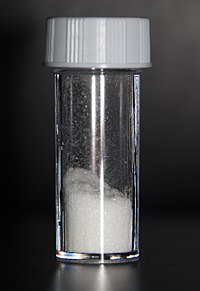Glutamatergic system
 |
|
 |
|
| Names | |
|---|---|
|
Systematic IUPAC name
2-Aminopentanedioic acid
|
|
| Other names
2-Aminoglutaric acid
|
|
| Identifiers | |
|
3D model (JSmol)
|
|
| ChEBI | |
| ChemSpider | |
| ECHA InfoCard | 100.009.567 |
| E number | E620 (flavour enhancer) |
| KEGG | |
| UNII | |
|
|
|
|
| Properties | |
| C5H9NO4 | |
| Molar mass | 147.13 g·mol−1 |
| Appearance | white crystalline powder |
| Density | 1.4601 (20 °C) |
| Melting point | 199 °C (390 °F; 472 K) decomposes |
| 7.5 g/L (20 °C) | |
| Solubility | 0.00035g/100g ethanol (25 °C) |
| Acidity (pKa) | 2.10, 4.07, 9.47 |
| -78.5·10−6 cm3/mol | |
| Hazards | |
| Safety data sheet | See: data page |
| NFPA 704 | |
| Supplementary data page | |
|
Refractive index (n), Dielectric constant (εr), etc. |
|
|
Thermodynamic
data |
Phase behaviour solid–liquid–gas |
| UV, IR, NMR, MS | |
|
Except where otherwise noted, data are given for materials in their standard state (at 25 °C [77 °F], 100 kPa).
|
|
|
|
|
| Infobox references | |
Glutamic acid is an α-amino acid with formula C
5H
9O
4N. It is usually abbreviated as Glu or E in biochemistry. Its molecular structure could be idealized as HOOC-CH(NH
2)-(CH
2)2-COOH, with two carboxyl groups -COOH and one amino group -NH
2. However, in the solid state and mildly acid water solutions, the molecule assumes an electrically neutral zwitterion structure −OOC-CH(NH+
3)-(CH
2)2-COOH.
The acid can lose one proton from its second carboxyl group to form the conjugate base, the singly-negative anion glutamate −OOC-CH(NH+
3)-(CH
2)2-COO−. This form of the compound is prevalent in neutral solutions. The glutamate neurotransmitter plays the principal role in neural activation. This anion is also responsible for the savory flavor (umami) of certain foods, and used in glutamate flavorings such as MSG. In highly alkaline solutions the doubly negative anion −OOC-CH(NH
2)-(CH
2)2-COO− prevails. The radical corresponding to glutamate is called glutamyl.
...
Wikipedia

